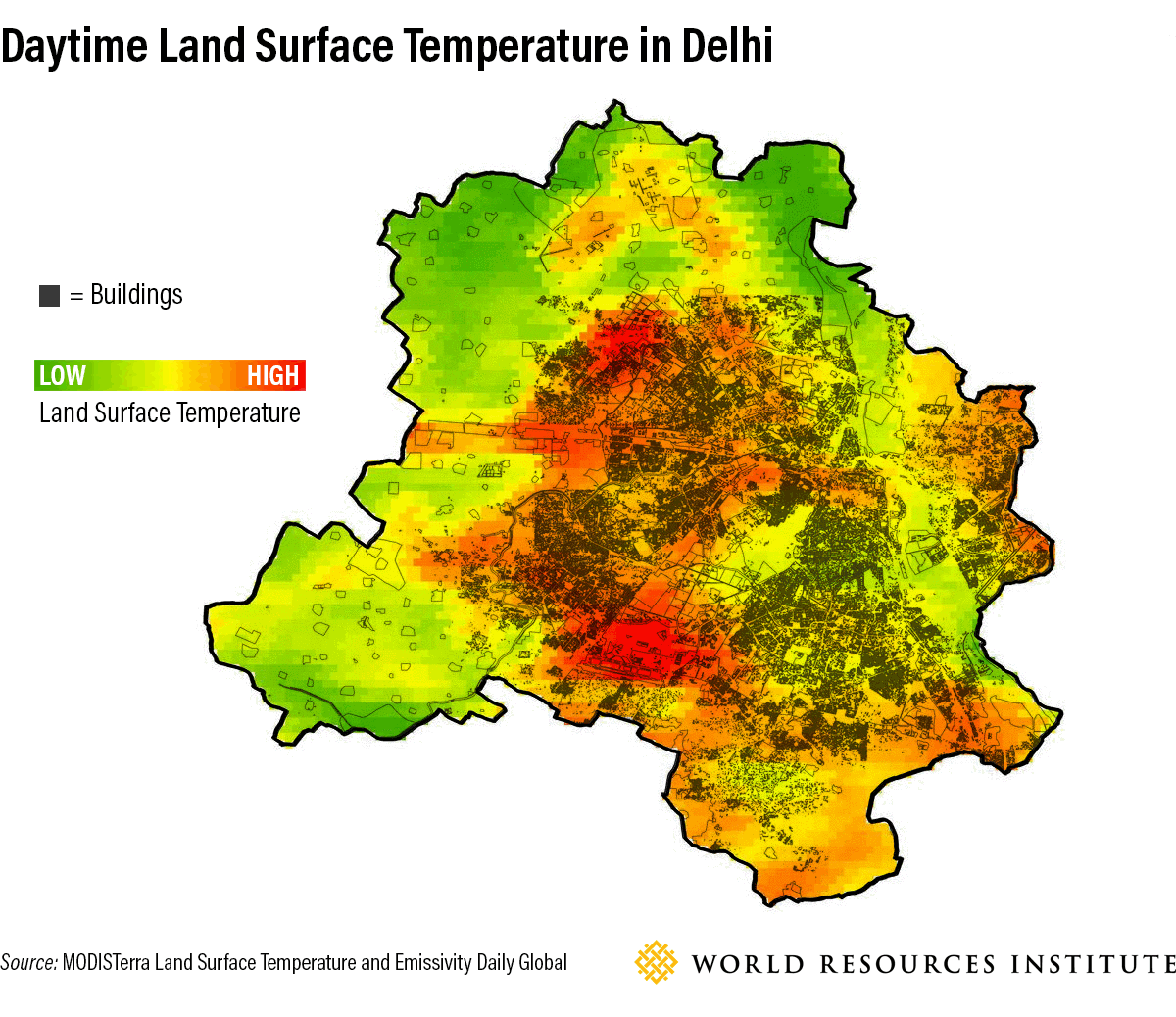
Buildings Are a Hidden Source of Indian Cities’ Extreme Heat
This blog post originally appeared in WRI Insights.
India is ground zero for extreme heat. More than 6,100 people have died from heat events since 2010. Half of the country reeled under severe heat waves this summer, when temperatures reached over 48 degrees Celsius (118 degrees F) in many places.
The urban heat island effect makes these extreme events even more severe in cities, which are warmer than their surrounding rural areas due to concentrated human activity and construction. The temperature difference between a city and its surrounding rural area can be as much as six degrees C (10.8 degrees F) in some cities.
While a combination of meteorological factors – including atmospheric pressure, wind patterns, precipitation and climate change — cause heat waves, Indian cities’ buildings have a lot to do with the heat residents feel.
Heat Waves, Urban Heat Islands and Air Pollution
Urban heat islands are directly linked to the shape, arrangement and use of buildings, and their relationships to streets and open spaces. Building design can aggravate, or improve, the impacts of heat waves, urban heat islands and local air pollution. For example:
Building Form and Density: The shape, size, height and placement of buildings impact how much heat is retained and circulated within the built environment. Tall buildings in densely-packed areas obstruct the sky and lower wind speeds, hampering air circulation and trapping heat. This design layout can also trap air pollutants at the ground level, exposing people to ozone, sulphur oxide, nitrogen oxide and particulate matter; these pollutants are responsible for many premature deaths from respiratory and cardiovascular diseases. Managing the density, height and shape of buildings, as well as separating buildings with green spaces or bodies of water, can allow for greater movement of hot air, avoiding local warming.
Passive cooling features can prevent extreme heat inside a building. The orientation of walls and windows that correspond with the sun’s direction and wind flow patterns can control the rate at which a building gains heat and room temperatures increase. In hot and dry regions, more compact building shapes can reduce heat absorbed by a building’s walls and roof.

Building Materials: Materials used to construct buildings in India today are not suitable for local weather conditions. For example, in Delhi and in several cities in North India, houses are commonly built with thin walls made of red burnt clay bricks, and roofs are made of concrete. These materials absorb heat quickly and transfer some of it indoors. At night, these materials release stored heat outside, warming the air and creating unwelcome heat long after the sun has set.
Hollow clay bricks, hollow concrete blocks or aerated concrete blocks store less heat than thick clay and are suitable for hot climates. Insulating walls and using alternative building materials can also prevent indoor temperatures from climbing too high. Innovative evaporative cooling walls, natural ventilation, proper orientation of doors and windows and the use of phase-change materials can also decrease a house’s cooling demand, thereby diminishing the effects of urban heat islands.
Energy Use in Buildings: Air conditioning and other appliances inside buildings release heat. Cool paints applied on roof surfaces, also known as cool roofs, reflect the sun’s rays, preventing heat gains that reduce the need for cooling inside the building. Green roofs and, increasingly, green walls provide additional insulation, reducing the indoor temperature and cooling demand in a similar way.
Better Buildings Can Minimize Heat Wave Impacts
Because India’s extreme heat and its impact on people is poised to worsen with climate change, increased population and rapid urbanization, India has taken aim with a Cooling Action Plan, the world’s first national policy roadmap to address cooling demands. However, urban heat islands are mentioned only once in the document and concrete steps to address the issue are missing. Mitigating urban heat islands must be at the core of this policy, which is set to be implemented in the next few years.
Government agencies can use remote sensing and other technologies to map and monitor urban heat islands to help identify vulnerable regions. Assessments on the amount of vegetation and presence of water, as well as materials used in buildings, can determine how hot neighborhoods can get. Having this information can help disaster management agencies better plan and implement actions during heat waves.
Large-scale housing programs, including Prime Minister Narendra Modi’s Housing for All scheme, which calls for the construction of 20 million houses by 2022, must not ignore urban heat islands and the growing intensity of heat waves. The initiative must incorporate mandatory requirements on building resilience, including low-cost passive cooling measures. The solution to minimizing urban heat islands lies in the way in which we plan, design and construct our buildings — not in the production of more air conditioners.
Cooler cities can only become a reality if all their stakeholders join hands. Together, governments, urban planners, architects, real estate developers, building owners and residents need to be innovative as they design better buildings that ensure cooler, more efficient cities.